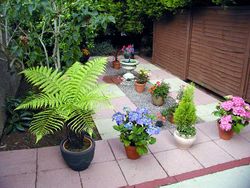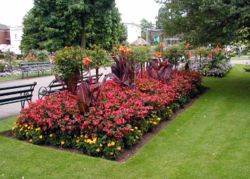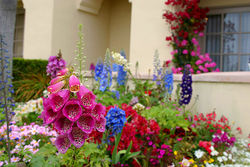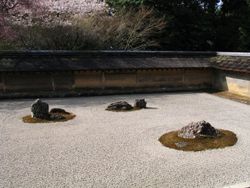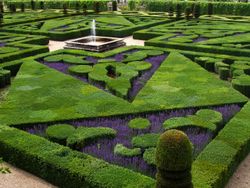Garden
2007 Schools Wikipedia Selection. Related subjects: Recreation
|
Gardens Around the World

An exceptionally large garden in Canada.
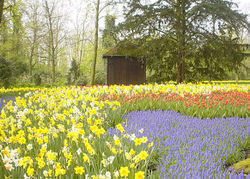
Keukenhof tulip garden in Lisse, Netherlands.
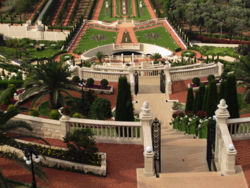
Bahai Gardens in Haifa, Israel.

Villa di Castello, one of the finest and oldest examples of Italian garden, in Florence, Italy.
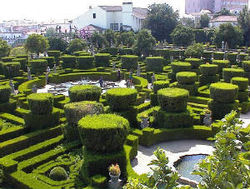
Castelo Branco, Portugal.
|
A garden is a planned space, usually outdoors, set aside for the display, cultivation, and enjoyment of plants and other forms of nature. The garden can incorporate both natural and man-made materials. The most common form is known as a residential garden. Western gardens are almost universally based around plants. Zoos, which display wild animals in simulated natural habitats, were formerly called zoological gardens. Some traditional types of eastern gardens, such as Zen gardens, use plants sparsely or not at all. Food-producing gardens are distinguished from farms by their smaller scale, more labor-intensive methods, and their purpose (enjoyment of a hobby rather than produce for sale). The gardening article discusses the differences and similarities between gardens and farms in greater detail.
Gardening is the activity of growing and maintaining the garden. This work is done by an amateur or professional gardener. A gardener might also work in a non-garden setting, such as a park, a roadside embankment, or other public space. Landscape architecture is a related professional activity with landscape architects tending to specialise in design for public and corporate clients.
Garden planning and design
Garden planning and garden design may be undertaken by a professional. A landscape architect is a professional who can plan and realise outdoor spaces. A garden designer is usually trained to plan and realise residential gardens.
The planner must give consideration to many factors:
- Purpose
- Existing conditions
- Financial constraints
- Maintenance implications
Elements of a garden
The elements of a garden consist of natural conditions and materials, as well as man-made elements:
Natural conditions and materials:
- Soil
- Rocks
- Light conditions
- Wind
- Precipitation
- Air quality
- Plant materials
Man-made elements:
- Terrace, patio, deck
- Paths
- Lighting
- Raised beds
- Outdoor art/sculpture, such as Gazebos
- Pool, water garden, or other water elements
Uses for the garden space
A garden can have many purposes— aesthetic, functional, and recreational. Uses for the garden space are:
- Cooperation with nature
- Plant cultivation
- Observance of nature
- Relaxation
- Family dinners on the terrace
- Children playing in the yard
- Reading and relaxing in the hammock
- Maintaining the flowerbeds
- Pottering in the shed
- Basking in warm sunshine
- Escaping oppressive sunlight and heat
- Growing useful produce
- Flowers to cut and bring inside for indoor beauty
- Fresh herbs and vegetables for cooking
Types of gardens
Gardens may feature a particular plant or plant type:
- Cactus garden
- Fernery
- Flower garden
- Herb garden
- Lawn
- Orangery
- Orchard
- Rose garden
- Vegetable garden
- White garden
- Winter garden
- Wildflower garden
Gardens may feature a particular style or aesthetic:
- French formal garden
- English landscape garden
- Alpine or rock garden
- Bonsai or miniature garden
- Chinese garden
- Geometric garden
- Informal garden
- Japanese garden
- Naturalistic garden
- Pizza garden
- Trial Garden
- Tropical garden
- Water garden
- Wild garden
- Xeriscaping
- Zen garden
- Dutch garden
- Children's Garden
Gardens may function in a particular manner:
- Botanical garden
- Communal garden
- Community garden
- Cottage garden
- Cutting garden
- Forest garden
- Raised bed gardening
- Residential garden
- Roof garden
- Sacred garden
- Square foot garden
- Vertical garden
- Water or soil-less gardening ( hydroponics)
- Walled garden
- Windowbox
- Zoological garden
Watering gardens
See rainwater, hand pump, tap water and drip irrigation.
History of gardening
See history of gardening.
Gardens in literature
- Asemic Writing
- The Garden of Eden
- Romance of the Rose
- Nathaniel Hawthorne's short-story " Rappaccini's Daughter"
- Frances Hodgson Burnett's The Secret Garden
- Midnight in the Garden of Good and Evil
- Wolfgang Amadeus Mozart's opera La Finta Giardiniera
- John Steinbeck's short-story " The Chrysanthemums"
Other similar spaces
Other outdoor spaces that are similar to gardens include:
- A landscape is an outdoor space of a larger scale, natural or designed, usually unenclosed and considered from a distance.
- A park is a planned outdoor space, usually enclosed ('imparked') and of a larger size. Public parks are for public use.
- An arboretum is a planned outdoor space, usually large, for the display and study of trees.
- A farm or orchard is for the production of food stuff.
- A botanical garden is a type of garden where plants are grown both for scientific purposes and for the enjoyment and education of visitors.
- A zoological garden, or zoo for short, is a place where wild animals are cared for and exhibited to the public.
